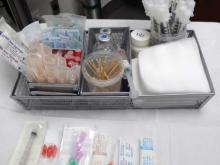LAS VEGAS – Soon after completing a cosmetic dermatologic surgery fellowship at the University of Pittsburgh Medical Center in 2001, Dr. Suzan Obagi stayed on to help launch one of the first academically based cosmetic surgery practices.
There was no previous business plan, no model at another university," Dr. Obagi said at the annual meeting of the American Academy of Cosmetic Surgery.
Today, toxin and filler treatments at the UPMC cosmetic surgery and skin health center are booked 4 months out, and Dr. Obagi said she treats about 1,200 patients with botulinum toxin type A each year and another 600-700 patients with dermal fillers. "If I’ve managed to build a successful cosmetic surgery practice in an academic setting, all of you can certainly do so in a noncampus setting," said Dr. Obagi, who directs the center.
Botulinum toxin type A and dermal fillers are the mainstays of any cosmetic surgery practice because patients strive for the instant results that come from using them. "Instant gratification: That’s what it’s all about," said Dr. Obagi. "Patients don’t want the prolonged down time or the stigma of looking like they’ve had something done. They love the natural look you can give them with injectables. For me, it’s a fun part of my practice. ... I get to be artistic."
Demand for injectables persists during times of economic uncertainty, she added. "When we had the downturn in the economy in 2008, we saw that the number of large [cosmetic surgery] cases dropped off, but the number of small procedures like injections of botulinum toxin type A and other fillers remained the same. What we did to get through some of that downturn was to open up more slots and get more patients in for these procedures."
She offered the following tips on how to enhance an injectables practice:
• Stand out from the competition. "Part of this is how your practice handles patients when they come in, but a bigger part of your practice is, how good are you with the needle?" Dr. Obagi said. "Your artistry is what’s going to speak volumes, so you have to differentiate yourself with your skill, and you have to make sure patients are able to come in every 3-4 months. If your schedule does not allow that to be booked, then you’re going to miss out."
• Set up rooms for efficiency. She said she equips each exam room with a wire basket full of needles, syringes, gauze, anesthetic, and other supplies she’ll need to treat every botulinum toxin type A and dermal filler patient who comes in. "I walk into a room and I can do two to three different things on that patient without having to step out of that room again," Dr. Obagi explained. "I don’t have to go fumbling for anything. I can spend all of that time talking to the patient, inquiring about their family, their adventures, learning about them. It diffuses the situation because patients know you’re going to come at them with a needle. They know they’re going to be feeling some pain shortly. Whatever you can do to calm them before you come at them with that needle really makes a difference."
To optimize the patient experience, she purchased powered procedure chairs for each exam room. "They’re about $10,000 per chair, but they have foot pedals for adjustment so you don’t have to touch anything with your hands," she said. "It’s all about comfort for you and the patient."
She also stocks the waiting room and each exam room with brochures that describe each procedure offered at the center.
• Evaluate each patient at every visit. If a patient has been treated with botulinum toxin type A for the last 5 years, she or he "may need it in other areas now that you’ve taken care of areas they were initially bothered by," Dr. Obagi said. "You need to keep reassessing the patient every time she or he comes in."
• Inject patients quickly and comfortably. Dr. Obagi said she uses the smallest needle possible and stabilizes the fingers on her nondominating hand "so my hand is steady; it’s not going to shake [during injection]," she said. "I have been on the receiving end of good and bad botulinum toxin type A treatments. What makes the difference is being quick with the injection. Make sure your hand is stabilized, and don’t go deeper than you need to. Botulinum toxin type A is not meant to be injected into the periosteum. Don’t go there; it hurts."


